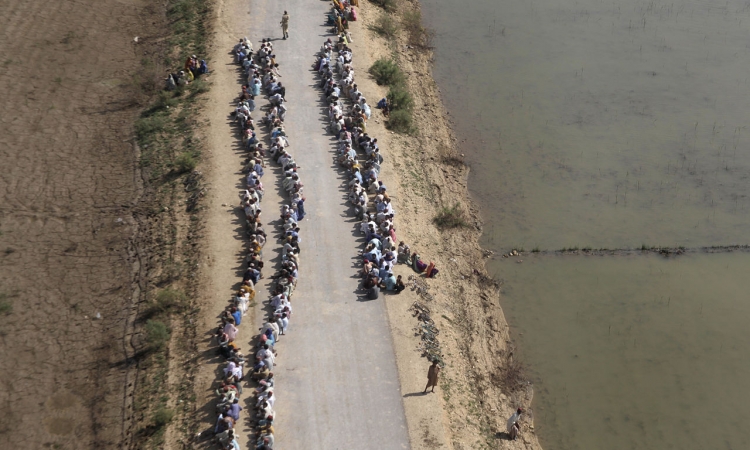There is no universal, legal definition of a ‘migrant’. In accordance with the mandate of the High Commissioner to promote and protect the human rights of all persons, the Office of the United Nations High Commissioner for Human Rights (OHCHR) has described an international migrant as “any person who is outside a State of which they are a citizen or national, or, in the case of a stateless person, their State of birth or habitual residence”. ‘Migrant’ is thereby used as a neutral term to describe a group of people who have in common a lack of citizenship attachment to their host country. It is without prejudice to the protection regimes that exist under international law for specific legal categories of people, such as refugees, stateless persons, trafficked persons and migrant workers.
Some policymakers, international organisations, and media outlets understand and use the word ‘migrant’ as an umbrella term to cover both migrants and refugees. For instance, global statistics on international migration typically use a definition of ‘international migration’ that would include many asylum-seeker and refugee movements.
In public discussion, however, this practice can easily lead to confusion and can also have serious consequences for the lives and safety of refugees. ‘Migration’ is often understood to imply a voluntary process, for example, someone who crosses a border in search of better economic opportunities. This is not the case for refugees who cannot return home safely, and accordingly are owed specific protections under international law.
A refugee is strictly defined in international law as a person who is fleeing persecution or conflict in her or his country of origin. As noted above, there is no such precise and universal definition of a migrant. It is important to underline that refugees are entitled to the full protection of refugee law, including protection from expulsion or return to situations of persecution where their life and freedom are at risk.
Blurring the terms ‘refugees’ and ‘migrants’ takes attention away from the specific legal protections refugees require, such as protection from refoulement and from being penalised for crossing borders without authorisation in order to seek safety. There is nothing illegal about seeking asylum - on the contrary, it is a universal human right. Conflating ‘refugees’ and ‘migrants’ can undermine public support for refugees and the institution of asylum at a time when more refugees need such protection than ever before.
Refugees are specifically defined and protected in international law. Refugees are people outside their country of origin because of feared persecution, conflict, violence, or other circumstances that have seriously disturbed public order, and who, as a result, require ‘international protection’. Their situation is often so perilous and intolerable, that they cross national borders to seek safety in nearby countries, and thus become internationally recognised as ‘refugees’ with access to assistance from states, UNHCR, and relevant organisations. They are so recognised precisely because it is too dangerous for them to return home, and they therefore need sanctuary elsewhere. These are people for whom denial of asylum has potentially deadly consequences.
Migrants in vulnerable situations
The concept of migrants in vulnerable situations has emerged to address the human rights situation of those migrants who do not qualify as refugees, but who are nevertheless in need of specific protection interventions. Migrants are not inherently vulnerable, but they can find themselves in vulnerable situations arising from the reasons for leaving their country of origin, the circumstances in which they travel or the conditions they face on arrival, or because of personal circumstances such as their age, disability or health status. Migrants in vulnerable situations are thus persons who are unable effectively to enjoy their human rights, are at increased risk of violations and abuse and who, accordingly, are entitled to call on a duty bearer’s heightened duty of care.
At the same time, it is similarly important to recall that international human rights law protects all individuals, regardless of their status. As recognised in the New York Declaration, there can be important overlaps in the challenges and vulnerabilities faced by people who move along the same routes, use the same forms of transport, and are similarly exposed to human rights violations, abuse and xenophobia. Moreover, today, and notwithstanding the gradual expansion of refugee protection, many people are compelled to leave their homes for reasons that do not fall within the refugee definitions, such as the adverse impacts of climate change including slow-onset processes or flight from food insecurity.
We need to treat all human beings with respect and dignity. We need to ensure that the human rights of migrants are respected. At the same time, we also need to provide an appropriate legal and operational response for refugees, because of their particular predicament, and to avoid diluting state responsibilities towards them.
For this reason, Migration Satellite always refers to ‘refugees’ and ‘migrants’ separately, to maintain clarity about the causes and character of refugee movements and not to lose sight of the specific obligations owed to refugees under international law.
SOURCES:
IMAGE CREDIT: Wikimedia Commons / Lance Cpl. Jhonson Simeon [Public domain]

